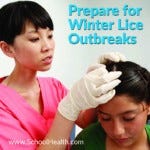Worried about lice outbreaks? Don’t lose your head.
- Jan 5, 2016
- 0 Comments
As students with their winter hats and caps return to school from break, we’ll see another visitor come with them: head lice.

Winter is a more active time for lice outbreaks as children have more close contact and often share coats, scarves, and hats with one another. And as lice outbreaks increase, so does the news around them. Lately parents and health professionals have been bombarded by over-hyped information campaigns about “super lice.” When we hear “super lice” we immediately conjure mental images disgusting bugs that are bigger and stronger than any kind of lice or nit that we’ve seen before. We picture them crawling around the scalps of children and jumping menacingly as they spread among the children of the school.
We naturally become concerned for the welfare of children when they hear these fear-inducing names. We look for ways to respond quickly, and with brutal force – hoping to prevent the spread of infestation. However, this response can sometimes create problems where none existed before.
Know the facts - “Super lice” are actually treatment-resistant lice with a media-hyped name. As an example, think of infections that are resistant to antibiotics. Treatment resistant lice are created in much the same way – through improper use of chemical applications or prescription treatments.
Interestingly, treatment resistant lice are not a new phenomenon. These kinds of lice have been present in schools for over 40 years.
Campaigns and media stories about super lice contain pieces of information that, while factual, are dangerous when taken without context. This can breed fear and cause further problems. For example, improper treatment with harsh chemicals and pesticides is one of the ways that treatment-resistant lice have become stronger. And sometimes parents resort to home remedies such as mayonnaise or olive oil that are not scientifically proven to be effective in treating lice. That's why manual removal through combing is a critical part of treating any lice infestation.
Combing is the only safe and effective method to end infestations especially for lice that are resistant to chemical treatments. School Health is pleased to offer the LiceMeister® Comb, which has the US Food and Drug Administration clearance as a medical device for the purpose of screening, detecting, and removing lice and their eggs (nits). Lice combs are also useful for removing dead nits from the hair in order to reduce diagnostic confusion and the chance of unnecessary re-treatments in the future.
How you can be prepared - Parents should become proactive in the examination and treatment (when necessary) of their children when they are exposed to lice. With proactive examinations, parents are able to identify lice concerns early which makes treatment easier, and helps prevent the spread of lice among students.
Sometimes, identifying head lice can be quite difficult. Using the LiceMeister Comb along with a magnifying lens is recommended to accurately identify lice. It can be easy to confuse nits with dandruff, hair spray droplets, and dirt particles.
- The best diagnosis is made by finding a live nymph or adult louse on the scalp or hair of a person.
- Nits attached firmly within 1/4" of the base of hair shafts may indicate an infestation if no moving nits are found. This is not accurate 100% of the time.
Watch for signs of lice - that "Tickly" Feeling Can Be a Sign of Head Lice
Head lice symptoms include:
- A tickling feeling or a sensation of something moving in the hair
- Frequent itching
- Sores from scratching
Oh no, head lice! The National Pediculosis Association (NPA) has identified tips to help parents and schools control head lice without the danger of exposing children and their environment to pesticides and other harsh chemicals.
NPA’s Tips for Parents:
- Know how to identify lice and nits in advance of outbreaks. (See NPA’s Critter Card)
- Know how to check heads at home so kids can arrive to the group setting lice and nit free. (See NPA’s LiceMeister comb teaching video)
- Know your child's school policy on head lice. Policies vary greatly from school to school.
Of course, the best way to treat lice is not to get them in the first place.
